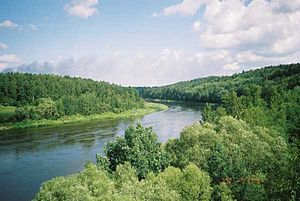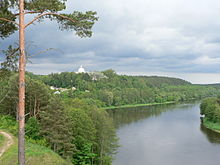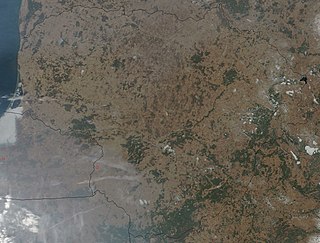
Lithuania is a country in the Baltic region of Europe. The most populous of the Baltic states, Lithuania has 262 km (163 mi) of coastline consisting of the continental coast and the "Curonian Spit" coast. Lithuania's major warm-water port of Klaipėda lies at the narrow mouth of Curonian Lagoon, a shallow lagoon extending south to Kaliningrad and separated from the Baltic sea by Curonian Spit, where Kuršių Nerija National Park was established for its remarkable sand dunes.
Transport in Lithuania relies mainly on road and rail networks.

The river Neris or Vilija rises in northern Belarus. It flows westward, passing through Vilnius and in the south-centre of that country it flows into the Nemunas (Neman) from the right bank, at Kaunas, as its main tributary. Its length is 510 km (320 mi).
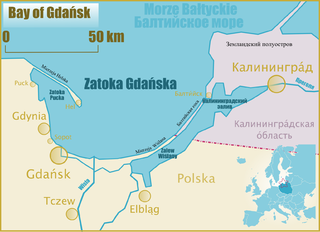
Gdańsk Bay or the Gulf of Gdańsk is a southeastern bay of the Baltic Sea. It is named after the adjacent port city of Gdańsk in Poland.

The Curonian (Courish) Spit is a 98-kilometre (61 mi) long, thin, curved sand-dune spit that separates the Curonian Lagoon from the Baltic Sea. It is a UNESCO World Heritage Site shared by Lithuania and Russia. Its southern portion lies within Kaliningrad Oblast of Russia, and its northern within southwestern Klaipėda County of Lithuania.

Lithuania Minor, or Prussian Lithuania, is a historical ethnographic region of Prussia, where Prussian Lithuanians lived, now located in Lithuania and the Kaliningrad Oblast of Russia. Lithuania Minor encompassed the northeastern part of the region and got its name from the territory's substantial Lithuanian-speaking population. Prior to the invasion of the Teutonic Knights in the 13th century, the main part of the territory later known as Lithuania Minor was inhabited by the tribes of Skalvians and Nadruvians. The land depopulated during the incessant war between Lithuania and the Teutonic Order. The war ended with the Treaty of Melno and the land was repopulated by Lithuanian newcomers, returning refugees, and the remaining indigenous Baltic peoples; the term Lithuania Minor appeared for the first time between 1517 and 1526.

Neman, is a town and the administrative center of Nemansky District in Kaliningrad Oblast, Russia, located in the historic region of Lithuania Minor, on the steep southern bank of the Neman River, where it forms the Russian border with the Klaipėda Region in Lithuania, and 130 kilometers (81 mi) northeast of Kaliningrad, the administrative center of the oblast. Population figures: 11,798 (2010 Russian census); 12,714 (2002 Census); 13,821 (1989 Soviet census).

The Nevėžis is the sixth longest river in Lithuania and one of the main tributaries of the Nemunas. The 209 km (130 mi) long Nevėžis flows entirely within Lithuania. Among the rivers that flow exclusively within Lithuania's borders, the Nevėžis is the second longest, after the Šventoji. Its source is in the Anykščiai District Municipality. The river first flows in a northwesterly direction, but at Panevėžys it turns southwest, and passing Kėdainiai, flows into the Neman just west of Kaunas near Raudondvaris.
Scalovia or Skalvia was the area of Prussia originally inhabited by the now extinct Baltic tribe of Skalvians or Scalovians which according to the Chronicon terrae Prussiae of Peter of Dusburg lived to the south of the Curonians, by the lower Nemunas river, in the times around 1240.

Nemunėlis is a river in northern Lithuania and southern Latvia. It originates 6 km south of Rokiškis. It is 191 kilometres long before its confluence with the Mūša, near Bauska, forming the Lielupe.

Panemunė is the smallest settlement with city status in Lithuania. It is situated on the banks of the Nemunas River opposite Sovetsk, 8 km (5.0 mi) south from Pagėgiai, in Tauragė County. It is a border checkpoint for traffic to and from Russia.

Nemunas Delta is the Lithuanian name for the Neman (Nemunas) River Delta, in Lithuania. Prior to post-World War II border changes, it was known in German as the Memel Niederung, as the Neman was for centuries called the Memel in German.

The Merkys is a river in southern Lithuania and northern Belarus. It flows for 13 km (8 mi) through Belarus, 5 km (3 mi) along the Belarusian–Lithuanian border, and 195 km (121 mi) through Lithuania before joining the Nemunas from the right bank near Merkinė.
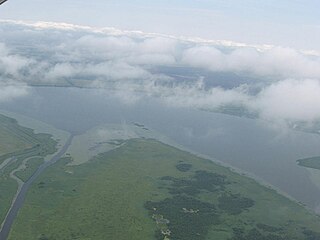
Krokų Lanka is the only lake of marine origin in Lithuania and the largest lake in the Šilutė District Municipality. It is located in the Nemunas Delta Regional Park on the Baltic Sea shore near Nemunas Delta and Ventė Cape. It covers a territory of 788 ha. Aukštumala bog, covering 3018 ha and used for peat production since 1882, is located just north of the lake and Mingė village is located on the western bank. In the south a narrow strip of water connects the lake with Atmata, a branch of the Neman River.

The Curonian Lagoon is a freshwater lagoon separated from the Baltic Sea by the Curonian Spit. Its surface area is 1,619 square kilometers (625 sq mi). The Neman River supplies about 90% of its inflows; its watershed consists of about 100,450 square kilometres in Lithuania and Russia's Kaliningrad Oblast.
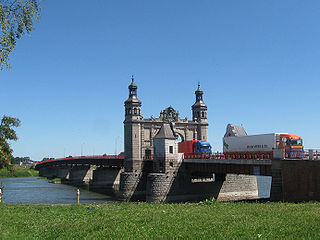
The Lithuania–Russia border is an international border between the Republic of Lithuania and Kaliningrad Oblast, an exclave of the Russian Federation. It is an external border of the European Union. The 274.9 km (170.8 mi) long border passes through the Curonian Spit and Curonian Lagoon, and then follows along the Neman River, Šešupė, Širvinta, Liepona, and Lake Vištytis. The sea border is another 22.2 km (13.8 mi). There is a tripoint between Lithuania, Russia, and Poland with a stone monument at 54°21′48″N22°47′31″E.

Rusnė Island is an island in Nemunas Delta, Šilutė District Municipality, Lithuania. It is located between Atmata and Skirvytė, distributaries of the Neman River, and the Curonian Lagoon. At 45 or 46 square kilometers, Rusnė is often considered Lithuania's largest island.

The Verknė is a 77-kilometre (48 mi) stream in Lithuania. It is a right tributary of the river Neman (Nemunas); their confluence is 3 km (1.9 mi) north of Birštonas.
